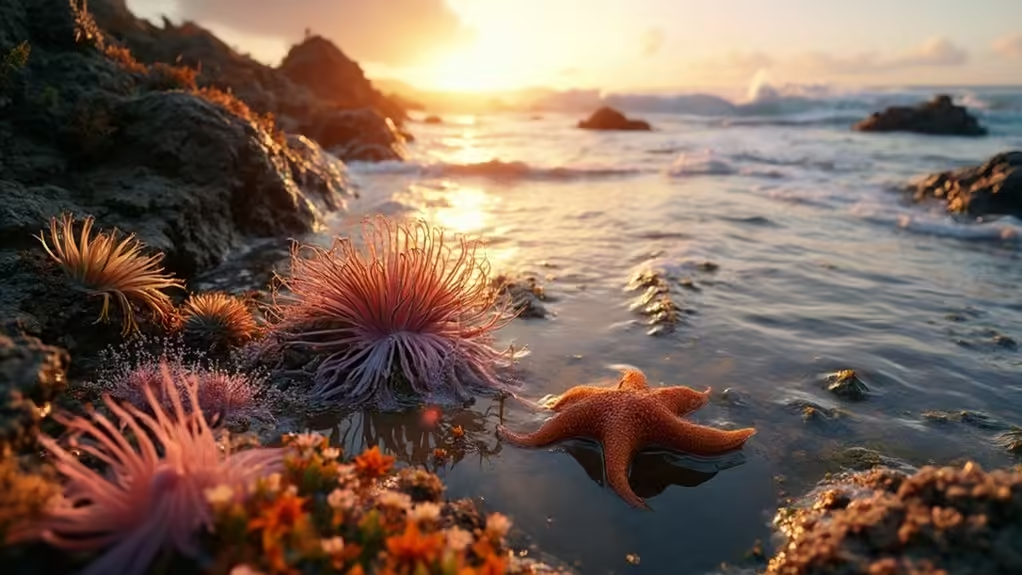California's tide pools are miniature marine marvels, offering you a glimpse into the ocean's hidden world. You'll find these lively ecosystems in the intertidal zone, revealed during low tide. They're home to a diverse array of sea life, including colorful anemones, scuttling crabs, and lively algae. To investigate safely, time your visit with low tide and wear waterproof boots for slippery surfaces. Remember to tread carefully and avoid disturbing the inhabitants. Popular spots like Cabrillo National Monument showcase California's coastal biodiversity. By observing responsibly, you'll help preserve these delicate ecosystems for future generations. Uncover the secrets of these underwater worlds and reveal a deeper appreciation for marine conservation.
Table of Contents
ToggleLearn More
- California's tide pools host diverse marine life, including sea anemones, crabs, and various algae species.
- Best tide pooling locations in California include Cabrillo National Monument and Leo Carrillo State Park.
- Visit during low tide, particularly below 0.5 feet, for optimal viewing of marine ecosystems.
- Essential gear for tide pooling includes waterproof boots, weather-appropriate clothing, and a marine life identification guide.
- Practice responsible exploration by observing without disturbing and walking only on bare rock to protect the ecosystem.
Discovering Tidepool Ecosystems
Have you ever peered into a miniature underwater world teeming with life? That's exactly what you'll experience when you investigate California's tide pools. These fascinating tidepool ecosystems form in the intertidal zone, where seawater gets left behind during low tide. It's like nature's own aquarium, giving you a glimpse into the secret lives of marine creatures.
As you venture into these coastal havens, you'll uncover a rich mosaic of California's biological diversity. Sea anemones wave their colorful tentacles, crabs scuttle between rocks, and various algae create a lively underwater garden. It's a chance to witness nature's resilience up close and personal.
To make the most of your tidepool journey, plan your visit during low tide, especially when it's below 0.5 feet. This guarantees you'll have the best view of the marine life hiding in these rocky pockets. Remember, though, that you're a guest in their home. Be mindful of protecting marine life by observing without disturbing. These educational opportunities offer more than just a fun day out – they're a chance to connect with and understand our coastal ecosystems.
Planning Your Coastal Adventure
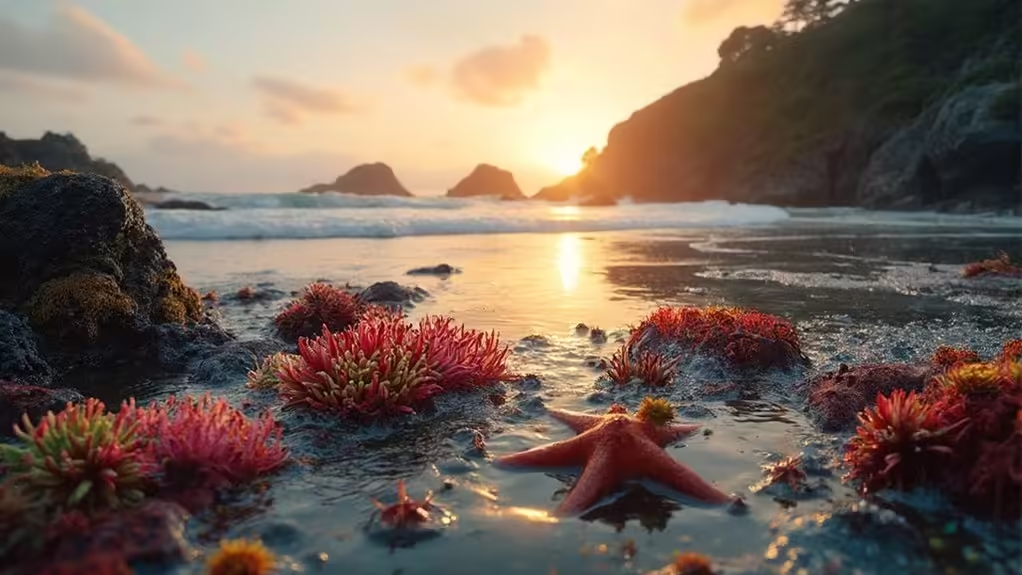
When planning your coastal expedition to investigate California's tide pools, timing is everything. You'll want to sync your visit with low tide, aiming for levels below 0.5 feet for the best marine life visibility and accessibility. Use the Tide Finder web app to check schedules and guarantee daylight hours align with optimal viewing conditions.
California offers prime tidepooling locations teeming with biodiversity. Consider these top spots:
| Location | Features | Visitor Resources |
|---|---|---|
| Cabrillo National Monument | Rich marine ecosystems | Guided tours |
| Leo Carrillo State Park | Diverse intertidal species | Educational programs |
Gear up for your coastal exploration with waterproof rubber boots, weather-appropriate clothing, and a smartphone loaded with the iNaturalist app for species identification. These essentials will enhance your experience and help you traverse the ever-changing coastal environment.
Safety should be your top priority. Move cautiously on slippery rocks, keep an eye on ocean conditions, and always tidepooling with companions. By following these guidelines, you'll guarantee a secure and enjoyable exploration of California's fascinating marine life, embracing the freedom of coastal revelation while respecting the delicate ecosystems you encounter.
Essential Gear and Safety
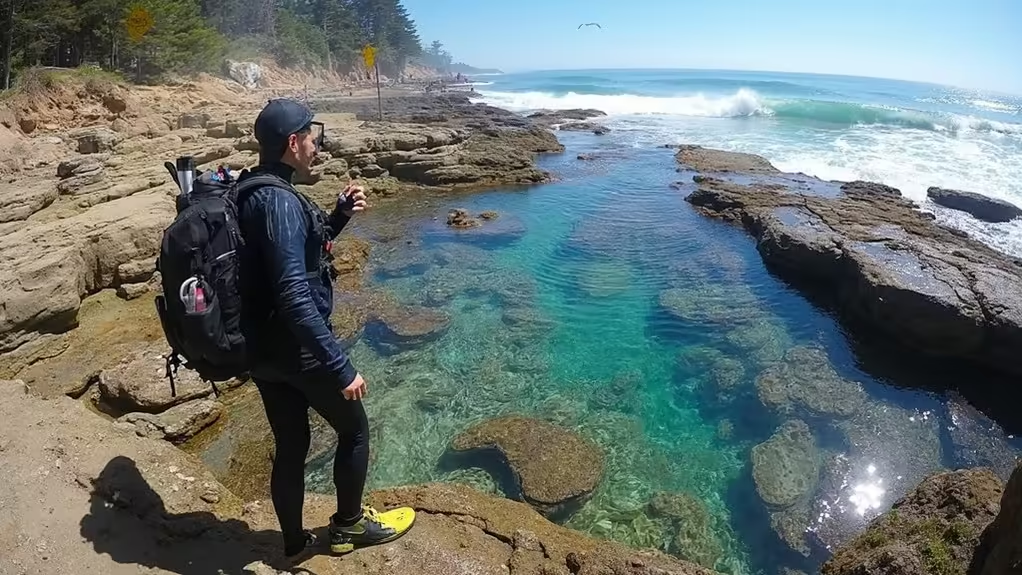
Now that you've planned your coastal outing, let's focus on the gear and safety measures you'll need for a successful tide pooling experience. First and foremost, invest in a pair of waterproof rubber boots. These are essential for navigating slippery rocks safely, as flip-flops can lead to dangerous falls. Don't forget to bring your smartphone equipped with the iNaturalist app, which will help you identify and log the fascinating marine species you'll encounter.
Dress in comfortable layers to adapt to the ever-changing coastal weather. This way, you'll be prepared for both sunny and chilly conditions. Always carry a first aid kit to address any minor injuries that might occur on the rocky surfaces. For added stability, consider using hiking poles. They'll give you better balance and make your tide pooling excursion safer and more enjoyable.
Marine Life Identification Guide
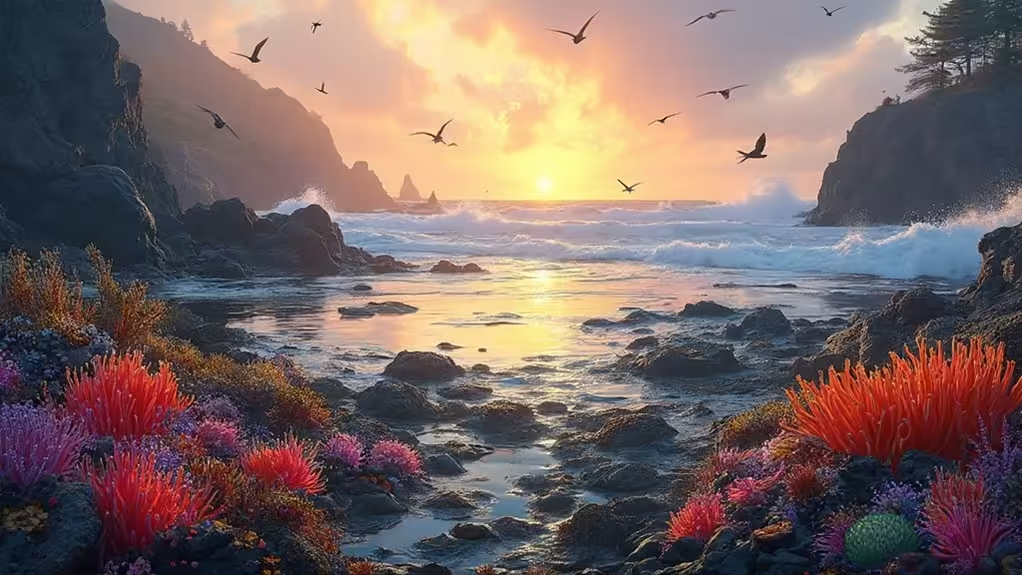
Exploring in and around tide pools reveals a fascinating array of marine life. You'll encounter a diverse range of species, from colorful sea stars to scuttling hermit crabs. These miniature ecosystems showcase California's coastal biodiversity, offering a glimpse into the underwater world.
As you venture out, keep an eye out for common inhabitants like lined shore crabs and octopuses. Locations such as Cabrillo National Monument are excellent spots to observe these creatures in their natural habitat. Don't forget to admire the lively algae, which not only provide food and shelter for marine species but also add splashes of color to the tide pools.
Conservation and Responsible Exploration
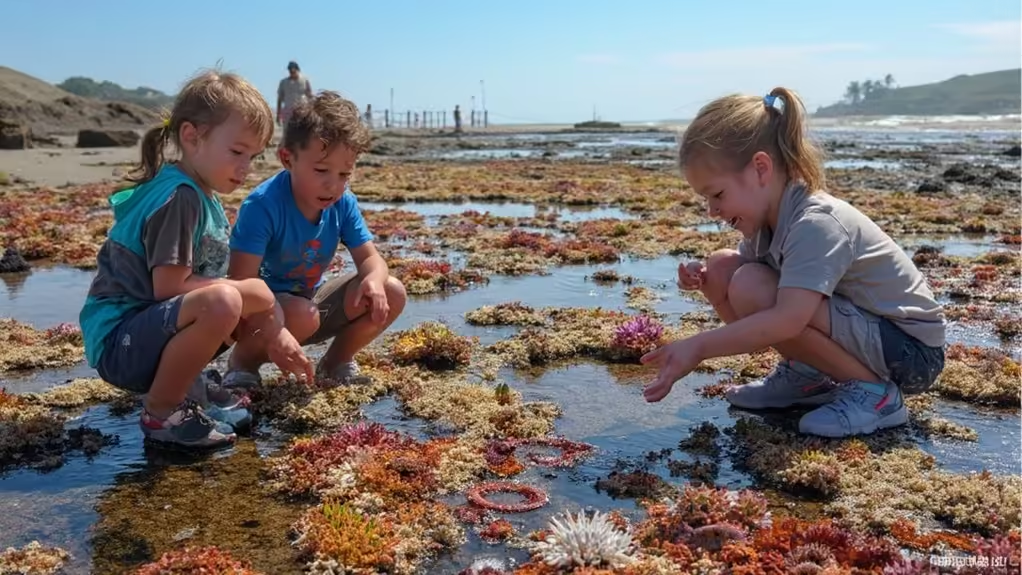
As you marvel at the lively marine life in California's tide pools, it's important to remember the delicate nature of these ecosystems. With over 1,000 species of vertebrates and countless invertebrates calling these coastal habitats home, responsible exploration is essential for their preservation.
You can play a significant role in marine conservation by following simple guidelines. Always walk on bare rock to minimize your impact, and resist the urge to pick up animals. By doing so, you're helping maintain the incredible biodiversity that makes these areas unique.
Environmental education is key to protecting tide pools and their inhabitants. Learning about the local ecosystem will help you understand why disturbing marine life can threaten endangered species and disrupt the entire habitat.
Get involved in community engagement efforts! Volunteer for habitat restoration projects and familiarize yourself with local regulations. Your actions can help preserve these natural wonders for future generations to enjoy.
Don't forget to gear up properly for your tidepooling excursion. Wear appropriate footwear and check tide schedules to guarantee a safe and responsible exploration of California's coast.
Frequently Asked Questions
What Is the Etiquette for Tide Pools in California?
You're in for an expedition! Tread carefully on bare rock, keeping marine life undisturbed. Don't touch or remove creatures—they're wild and free. Watch your step, keep kids close, and follow local rules. Let's preserve nature's wonders together!
What Beaches in California Have Tide Pools?
You'll find awesome tide pools across California's coastline. Check out Del Norte Coast Redwoods, MacKerricher, Fitzgerald Marine Reserve, Salt Point, Natural Bridges, Point Lobos, Leo Carrillo, and Cabrillo National Monument. These spots offer incredible marine life investigation opportunities. Go investigate! If you’re looking to escape the crowds and explore some underrated coastal gems, consider checking out Bean Hollow State Beach and Glass Beach. These spots may not be as well-known as the others, but they still offer fantastic tide pooling experiences with diverse marine life waiting to be discovered. So, pack your sunscreen, grab your camera, and get ready to explore the hidden treasures along California’s coastline! And if you’re looking to try your hand at surfing, California also boasts some top beginners surfing beaches. From the gentle waves at Surfrider Beach in Malibu to the beginner-friendly breaks at Pacifica State Beach, there are plenty of options for those just starting out. So, whether you’re interested in tide pooling or catching some waves, California’s coastline has something for everyone to enjoy.
Are Tide Pools Protected in California?
Yes, tide pools are protected in California. You'll find regulations safeguarding these delicate ecosystems. While you're free to investigate, you can't take marine life or disturb habitats. It's all about preserving nature's wonders for everyone to enjoy.
What Animals Are in the Tide Pools in Northern California?
You'll uncover a lively world teeming with life: colorful sea anemones sway, hermit crabs scuttle, and starfish cling. You're free to investigate diverse ecosystems where over 6,500 plant species and 1,000 vertebrates thrive in Northern California's wild tide pools.

